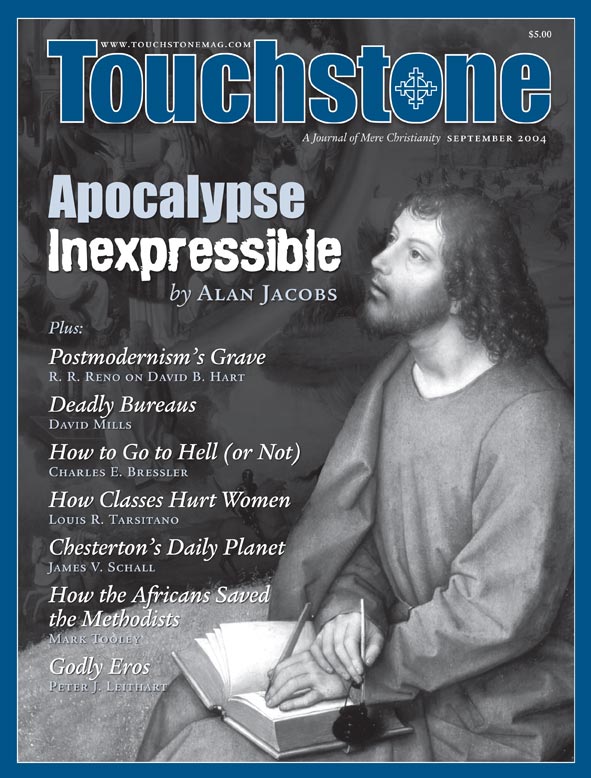Loose Canon
The Shape of Sola Scriptura
by Keith A. Mathison
Canon Press, 2001
(364 pages; $17.00, paperback)
reviewed by Craig D. Allert
In The Shape of Sola Scriptura, Keith Mathison expresses concern over the growing number of Evangelicals who are abandoning the doctrine as indefensible, and appeals for a return to its proper historical/contextual understanding. The sola scriptura that Evangelicals are rejecting, he argues, is really not the proper Evangelical understanding at all.
The first of the book’s four parts, “The Historical Context,” traces the idea of sola scriptura from the early Church to the post-Reformation era. Depending on Heiko Oberman’s studies of Scripture and tradition, including The Harvest of Medieval Theolog y, he points out that the debate between the magisterial reformers and the Catholic Church over the source(s) of revelation was not over the choice between Scripture or tradition, but rather over two rival concepts of tradition. He traces the development of these concepts hrough history and uses the Oberman-coined terms “Tradition I” and “Tradition II” to focus and summarize them.
Tradition I, the view held by the vast majority of the theologians of the early Church, holds that Scripture and tradition coinhere in such a manner that Scripture must be interpreted within the context of the ancient rule of faith and the ecumenical creeds. Tradition II, a development of the late Middle Ages resulting from the growing importance of canon law, introduced extra-biblical oral tradition into the original context as an interpretive authority.
The magisterial reformers, who adhered to Tradition I, were speaking out against the ascendancy of Tradition II, so that the “ sola” in the great slogan was in fact a call for Scripture in the context of Tradition I alone, unencumbered by a dual-source theory. They were not calling for interpretation of Scripture divorced from the Church and carried out by individuals possessed of the Holy Spirit, but regarded the Spirit as working principally within the order and authority of the Church.
If this is the proper understanding of sola scriptura, how have American Evangelicals so badly misrepresented their own history? The answer, Mathison says, lies in the influence of the radical wing of the Reformation as it developed in America. The radicals held to what Mathison calls solo scriptura—what in his Reformation Thought Alister McGrath calls “Tradition 0.” Radicals like Conrad Grebel, Melchior Hoffmann, and Sebastian Franck rejected tradition of any kind in favor of the internal witness of the Holy Spirit, divorced from the past confessions of the Church. This understanding was combined with Enlightenment rationalism and American democratic populism to create the version of Tradition 0 that prevails within Evangelicalism today.
In this section, which comprises almost half the text of the entire book, some of his citations of primary-source material resort to the same proof-texting that he himself criticizes. This is particularly true of the first chapter. With the exception of his section on Calvin’s Institutes, he repeatedly cites primary-source material through secondary sources. There is some irony involved here, for part of the Evangelical problem Mathison is trying to correct is the lack of sustained, serious engagement with the primary sources.
Scripture & Canon
In Part Two, “The Witness of Scripture,” the author examines “the most important” biblical passages dealing with Scripture, tradition, and the Church. Here he begins to deal with the implication of issues raised by the first part. He recognizes the importance of canon issues, but he unfortunately fails to realize many of their subtleties and nuances. He repeatedly refers to Scripture and canon (a closed list of documents that cannot be expanded or reduced) as synonymous, and continues the practice throughout the book.
Recent studies, however, such as those of Everett Kalin and Harry Gamble, have called attention to the need to distinguish between these two terms in scholarly examination of the ancient world. The problem is that in the ancient world “Scripture” referred to religiously authoritative literature, not a closed canon. We know that many of the Fathers of the first centuries cited many non-canonical documents as Scripture.
Mathison also treats as given the idea that Jesus and the apostles inherited a closed Old Testament canon. Lack of consideration of the possibility that the “Old Testament” was open at the time of Jesus and the apostles, however, leaves Mathison open to the charge of an anachronistic conceptualization of canon.
These issues are important because they deal with biblical authority. Mathison appeals to the unique status of “Scripture,” but if the biblical references to Scripture do not refer to a closed canon (the canon we have), the appeal to them to support the unique authority of the Bible is jeopardized.
Perhaps the most frustrating aspect of Part Two and Part Three, “The Theological Necessity of Sola Scriptura,” is their use of sola scriptura as a sustained apologetic against Roman Catholicism and, to a lesser extent, Orthodoxy. While the criticisms offered by Mathison deserve a hearing, one must ask whether this is the appropriate forum. It is entirely possible, for example, that his argument for sola scriptura as informed by Tradition I could get lost in his polemic against papal primacy.
Mathison admits in Part Four, “Objections and Issues,” that most, if not all, the issues covered by its first two chapters have been addressed in the book already. His desire to be clear and thorough is laudable, but the end of the book becomes repetitive to the point of annoyance. For example, in dealing with Roman Catholic objections to sola scriptura, not only does he cover the same ground he covered earlier in the book, but he also repeatedly observes that what the Catholics criticize is not the classical Reformation doctrine. He is correct, but the constant repetition is unnecessary and fails to give proper emphasis to his primary issue: the misunderstanding of sola scriptura among Evangelicals.
In The Shape of Sola Scriptura we have a book written as an appeal to Evangelicals to come to terms with their own theological history. This is much needed, and Mathison should be commended for presenting an understandable account of a confusing issue. On this count I would heartily recommend the book.
The polemic, however, tempers initial enthusiasm. The classic doctrine of sola scriptura has the potential to unite the various traditions of Christianity on a foundational issue. Unfortunately, Mathison fails to discuss this, choosing rather to offer an apologetic against other traditions. Today, perhaps as never before, we are witnessing significant dialogue between the traditions that needs to be heard and understood by popular Evangelicalism. His target readers could lose Mathison’s important discussion of sola scriptura in his apologetic against “rival” traditions. What begins as an attempt to open the Evangelical mind to its ancient and universal heritage, may in the end actually contribute to its deeper entrenchment.
Craig D. Allert is assistant professor of Religious Studies & Christian History and coordinator of the Christianity and Culture program at Trinity Western University in Langley, British Columbia.
subscription options
Order
Print/Online Subscription

Get six issues (one year) of Touchstone PLUS full online access including pdf downloads for only $39.95. That's only $3.34 per month!
Order
Online Only
Subscription

Get a one-year full-access subscription to the Touchstone online archives for only $19.95. That's only $1.66 per month!
bulk subscriptions
Order Touchstone subscriptions in bulk and save $10 per sub! Each subscription includes 6 issues of Touchstone plus full online access to touchstonemag.com—including archives, videos, and pdf downloads of recent issues for only $29.95 each! Great for churches or study groups.
Transactions will be processed on a secure server.
more from the online archives
calling all readers
Please Donate
"There are magazines worth reading but few worth saving . . . Touchstone is just such a magazine."
—Alice von Hildebrand
"Here we do not concede one square millimeter of territory to falsehood, folly, contemporary sentimentality, or fashion. We speak the truth, and let God be our judge. . . . Touchstone is the one committedly Christian conservative journal."
—Anthony Esolen, Touchstone senior editor









